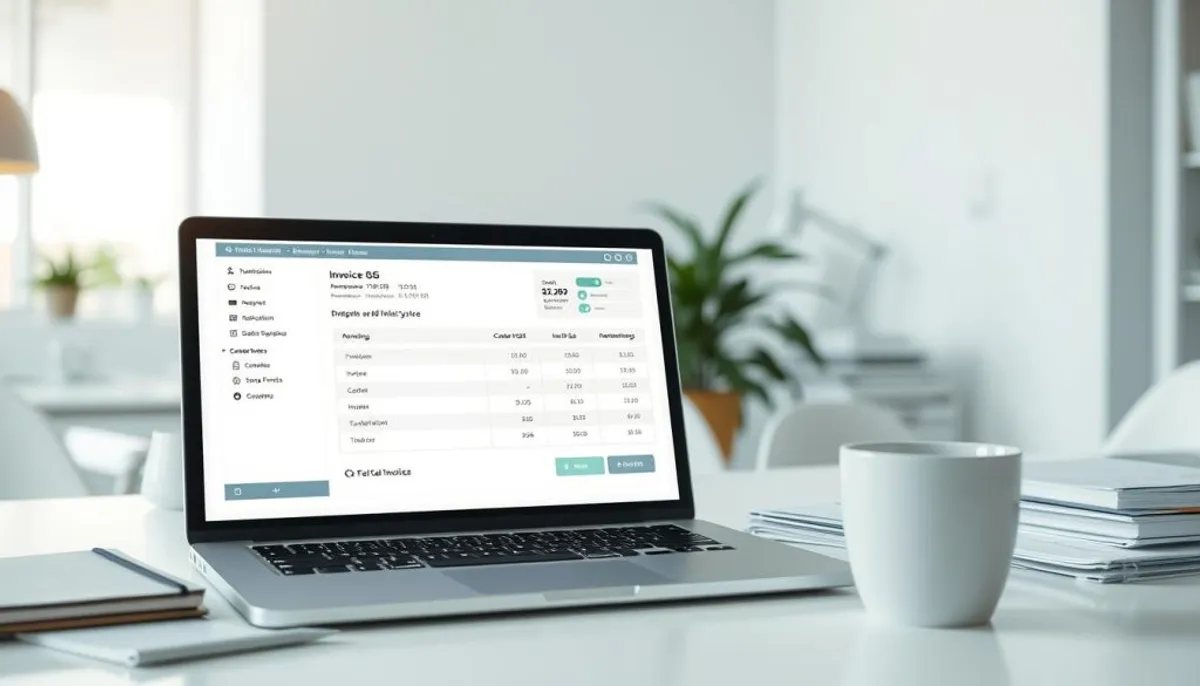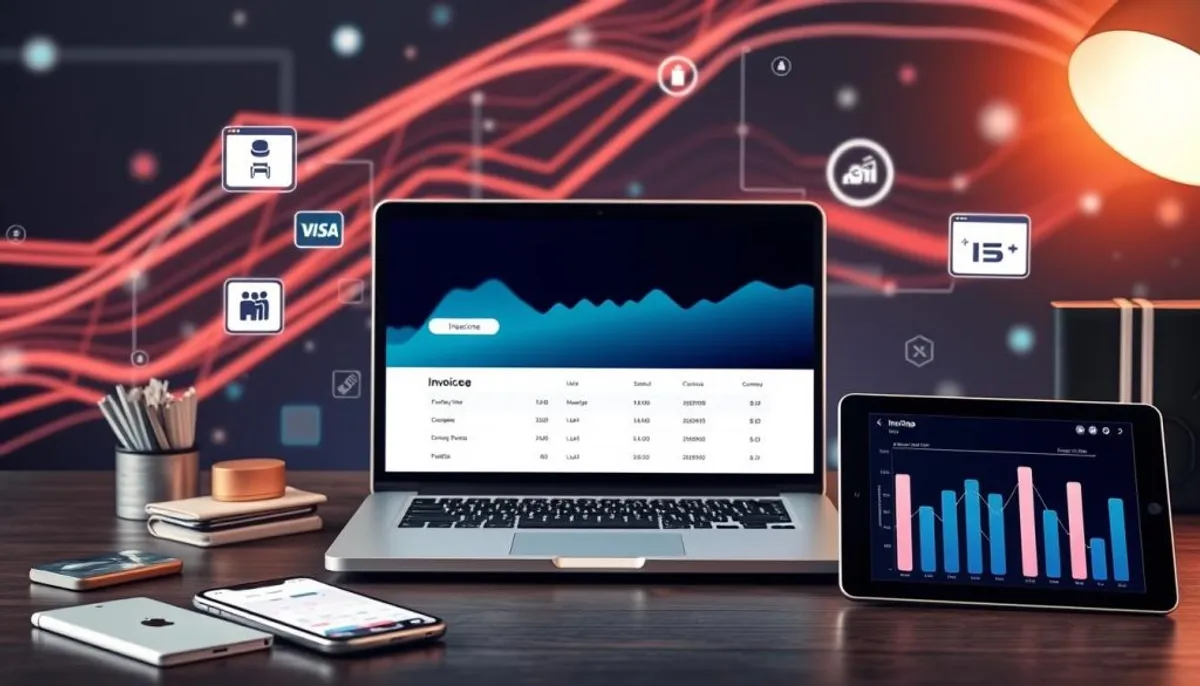Cash flow is the lifeblood of any business. Yet, many companies struggle with late payments, which can disrupt operations and strain client relationships. If you’re wondering how to help get my customers to pay their invoices on time, you’re not alone. A recent survey revealed that most U.S. small businesses face payment delays, with some waiting up to 30 days past the due date.
Effective invoice management is crucial for maintaining financial health. From setting clear payment terms to implementing smart billing technology, there are numerous strategies to encourage prompt payments. Let’s explore expert tips to streamline your invoicing process and reduce overdue invoice collections.

Did you know that design agencies often face significant payment delays? According to a 2022 Late Payments Report, 50% of their invoices are paid up to 60 days (or more) too late. This can lead to agencies spending up to 13 hours per week chasing payments. By implementing effective strategies, you can avoid these pitfalls and maintain a steady cash flow.
Key Takeaways
- Set clear payment expectations upfront
- Create detailed and professional invoices
- Use automated invoicing tools
- Offer multiple payment options
- Implement a consistent follow-up system
- Consider upfront payment or split payment models
- Enforce strict payment policies when necessary
The Importance of Timely Invoice Payments
Timely invoice payments are vital for a business’s success. Effective management of accounts receivable and cash flow from invoices can significantly impact a company’s financial stability. Understanding the significance of prompt payments is essential for various business operations.
Maintaining Cash Flow
Cash flow is the backbone of any business. Timely payments from clients ensure a consistent income stream. However, 25% of businesses face delays of 20-30 days for payments. Such delays can severely hinder a company’s ability to fulfill its financial commitments.
Covering Business Expenses
Meeting daily expenses is crucial for a business’s survival. These expenses include office supplies, internet, and payroll. Late payments can delay these essential costs, potentially affecting employee morale and productivity.
Preserving Client Relationships
Prompt payments are key to maintaining positive client relationships. Consistent on-time payments create a professional and smooth dynamic. Conversely, tolerating late payments can establish a harmful precedent, suggesting that delayed payments are acceptable.
| Payment Timing | Likelihood of Payment |
|---|---|
| On due date | 95% |
| 30 days overdue | 89% |
| 90 days overdue | Below 70% |
The table highlights the decline in payment likelihood as invoices age. This emphasizes the critical role of prompt invoicing and efficient accounts receivable management in enhancing cash flow from invoices.
Setting Clear Payment Terms from the Start
Establishing clear payment terms is crucial for effective customer communication regarding payments. Doing so upfront prevents misunderstandings and ensures timely payment. Let’s delve into strategies for setting payment terms that benefit both parties.
Payment terms vary based on business needs. For instance, 29% of businesses demand partial or full payment before shipping goods. Another 14% require payment upon receipt, while 23% expect cash with the order. Cash in Advance is another common term, used by 29% of businesses.
End of Month terms, where payment is due by the month’s end, are favored by 35% of businesses. These terms offer flexibility and can enhance cash flow. It’s worth noting that 82% of small businesses fail due to cash flow issues, underscoring the critical role of clear payment terms.
| Payment Term | Usage Percentage |
|---|---|
| End of Month | 35% |
| Cash Before Shipment | 29% |
| Cash with Order | 23% |
| Payment on Receipt | 14% |
In crafting invoice payment reminders, politeness is key. Invoices with “thank you” in the payment terms are settled 90% faster. Those with “please” are paid 88% faster. Notably, 45% of invoices with “thank you” are paid within a week. Such small gestures can greatly influence your cash flow.
By establishing clear payment terms and using polite language in your invoices, you can enhance your business’s financial health. This approach also fosters positive client relationships.
Streamlining Your Invoicing Process
Efficient accounts receivable management hinges on a streamlined invoicing process. Optimizing this approach can enhance cash flow and diminish payment delays. Let’s delve into essential strategies to refine your invoice management.
Creating Detailed and Professional Invoices
Accurate and professional invoices are pivotal for timely payments. Ensure they include a detailed breakdown of project milestones and all work completed during the billing period. Such transparency fosters client understanding of the value they receive, thereby reducing disputes.

Automating Invoice Generation and Delivery
Automation revolutionizes invoice follow-up strategies. Modern job management software, such as Organilog, introduces features for electronic invoice generation, quote creation, and contract management. This automation streamlines the process from job completion to payment receipt.
Offering Multiple Payment Options
Offering a variety of payment methods caters to client preferences. Despite a decline in cash payments for online orders to about 2%, digital options like GooglePay, Amazon Pay, and PayPal are increasingly favored. Credit cards remain the preferred choice for online transactions, followed by digital wallets and bank transfers.
| Payment Method | Popularity |
|---|---|
| Credit/Charge Cards | Most Popular |
| Digital/Mobile Payments | Second Most Popular |
| Debit Cards | Third Most Popular |
| Bank Transfers | Fourth Most Popular |
By adopting these strategies, you can notably enhance your invoicing process and overall accounts receivable management.
Implementing Effective Payment Incentives
Enhancing cash flow from invoices is paramount for business prosperity. Offering payment incentives is a proven strategy. Early payment discounts, for example, can prompt clients to settle their bills swiftly. A 2% discount for payments within 15 days can notably encourage quicker transactions.
Invoice payment reminders are instrumental in this endeavor. Automated notifications that highlight discounts for early payments or penalties for tardiness keep clients on schedule. This method not only boosts cash flow but also fosters enduring client relationships.
Adopting a “2/15 Net 30” policy is advisable. It incentivizes clients to pay promptly by offering savings. For ongoing projects, retainers can assist clients in budgeting, ensuring a steady cash flow.
| Payment Incentive | Benefit | Impact on Cash Flow |
|---|---|---|
| 2% discount for early payment | Motivates prompt payments | Improves short-term cash flow |
| Automated reminders | Keeps clients informed | Reduces late payments |
| Retainer agreements | Stabilizes client budgets | Ensures consistent cash flow |
By integrating these tactics, businesses can markedly enhance their cash flow from invoices. Regular reminders and enticing incentives forge a mutually beneficial relationship between the company and its clients.
Help Get My Customers to Pay Their Invoices: Proactive Strategies
Ensuring timely payment from customers is vital for sustaining a robust cash flow. By adopting proactive measures, you can enhance your payment collection and communication with clients. This approach is essential for the financial health of your business.
Sending Friendly Payment Reminders
Initiate polite reminders before the due date to prompt clients to fulfill their payment obligations. Research indicates that 87% of businesses face delayed payments. Friendly reminders can lower this figure, thereby boosting your cash flow.
Offering Flexible Payment Plans
Introduce flexible payment options to align with clients’ financial capabilities. Consider progressive payments for extensive projects or retainer agreements with initial payments. Some businesses offer a 5% discount for retainer agreements, motivating clients to make timely payments and ensuring a steady cash flow.
Providing Outstanding Customer Service
Exceptional customer service is paramount for prompt invoice payments. Address billing inquiries and concerns expeditiously to avert payment delays. Transparent communication regarding payment terms and expectations fosters trust and prevents miscommunication.
| Payment Strategy | Effectiveness |
|---|---|
| Automated Invoicing | 4x faster payments |
| Multiple Payment Options | Increased on-time payments |
| Early Payment Discount | 2% discount for 2-day payment |
| Late Payment Fee | 1-1.5% charge for late payments |
By integrating these proactive strategies, you can streamline your customers’ payment process. This will not only enhance your business’s financial standing but also strengthen client relationships.
Leveraging Technology for Faster Payments
Technology is pivotal in enhancing cash flow from invoices. By adopting intelligent solutions, enterprises can refine their invoice follow-up tactics. This leads to quicker receipt of payments.
Using Online Payment Portals
Online payment portals facilitate swift invoice payments for clients. These platforms offer a variety of payment avenues, such as credit cards, bank transfers, and digital wallets. By accommodating diverse client preferences, businesses expedite the payment cycle.
Integrating Accounting Software
Accounting software integration streamlines invoicing and payment tracking. It automates the invoicing process, sends timely reminders, and updates transactions in real-time. This automation minimizes manual errors and conserves time, enabling businesses to concentrate on their primary functions.
Implementing Electronic Invoicing
E-invoicing dramatically shortens the interval between invoice dispatch and payment receipt. It obviates postal delays, ensuring invoices are delivered to clients immediately. Some systems enable clients to pay directly from the electronic invoice, further enhancing the efficiency of the process.

Embracing these technologies can yield substantial benefits. Here are some compelling statistics:
| Technology Adoption | US Businesses | UK Businesses |
|---|---|---|
| Using real-time payments | 60% | 48% |
| Planning to adopt in 12 months | 25% | 35% |
| Importance of quick payments | 73% | 69% |
By harnessing these technological advancements, businesses can markedly enhance their invoice follow-up strategies. This, in turn, significantly boosts cash flow from invoices. The essence lies in selecting the most suitable tools that resonate with your business objectives and client needs.
Addressing Late Payments Professionally
Late payments can severely impact cash flow and business relationships. It is imperative to employ effective strategies for managing overdue invoices. A proactive stance often leads to favorable outcomes.
Initiate by sending a courteous reminder the day after the payment is due. This action can notably enhance your payment prospects. Subsequent follow-ups should occur at regular intervals: a week, two weeks, and a month post-due date. Clear communication is paramount. Ensure your reminders include vital information such as invoice number, amount, due date, and available payment options.
Present various payment options to facilitate bill settlement for your clients. Options like credit cards, money orders, checks, and online payment portals enhance flexibility. It is noteworthy that email reminders are the most effective for payment requests.
If emails fail to elicit a response, consider phone calls as an alternative. They can be more effective in specific scenarios. For those who consistently fail to pay, halting work to highlight the urgency of the invoice may be necessary. As a final measure, legal actions such as liens or small claims court might be required.
Throughout your communication, maintain a professional demeanor. Many late payments stem from simple oversights, making a gentle reminder often sufficient. Addressing late payments promptly and with courtesy helps safeguard client relationships while ensuring your business receives its rightful compensation.
Building Strong Client Relationships for Timely Payments
Establishing robust client relationships is paramount for ensuring timely invoice payments. Effective communication regarding payments can notably enhance your likelihood of receiving payments on schedule. We will delve into strategies aimed at facilitating timely payments while fostering enduring client relationships.
Regular Communication and Updates
It is essential to maintain client engagement through regular updates. Offer consistent project status reports and maintain transparency regarding progress. This proactive communication strategy fosters trust and ensures that payment deadlines remain a priority for your clients.
Demonstrating Value in Your Services
Illustrate the intrinsic value of your services. Emphasize significant achievements, milestones, and positive results. When clients perceive the tangible benefits of your work, they are more inclined to prioritize your invoices for payment.
Personalizing Your Approach
Adapt your communication style to align with each client’s preferences. Some may favor detailed emails, while others might prefer brief phone calls. This personalized touch strengthens client relationships and can expedite payment processes.
| Strategy | Impact on Payment Likelihood |
|---|---|
| Regular updates | 95% payment on due date |
| Value demonstration | 89% payment within 30 days |
| Personalized approach | 70% payment even after 90 days |
It is important to remember that cultivating strong client relationships transcends mere payment collection. It is about forging enduring partnerships that mutually benefit both parties. By prioritizing clear communication, showcasing the value of your services, and tailoring your approach, you will not only elevate your payment success rates but also pave the way for future business collaborations.
Legal Considerations for Unpaid Invoices
Understanding your legal options is paramount when dealing with overdue invoice collections. In 2022, a staggering 49% of invoices issued by US businesses became overdue. This underscores the critical need for effective accounts receivable management. While collection agencies can recover up to 80% of owed amounts in B2B scenarios, their success rate has declined to 20% over the last decade.
Before resorting to legal action, explore alternative strategies. Reconnect through email, phone, and social media to engage the client. If a payment plan is considered, aim to spread payments over no more than six months. It’s essential to have written agreements to prevent misunderstandings. Additionally, ceasing work for non-paying clients can mitigate risks associated with providing additional unpaid services.
If legal action is deemed necessary, evaluate the costs carefully. Collection agencies often charge fees up to 25% of the collected amount. For small claims court, prepare to file a complaint, present your case, and await judgment. Some states prohibit attorney representation in small claims court, so consider whether legal costs outweigh the outstanding amount. By grasping these legal considerations, you can make informed decisions to safeguard your business and preserve professional relationships.
RelatedRelated articles



